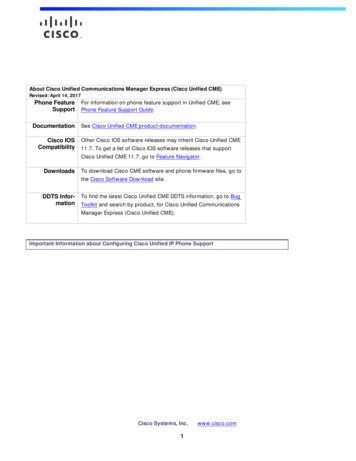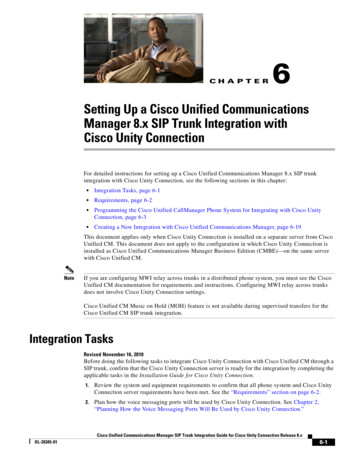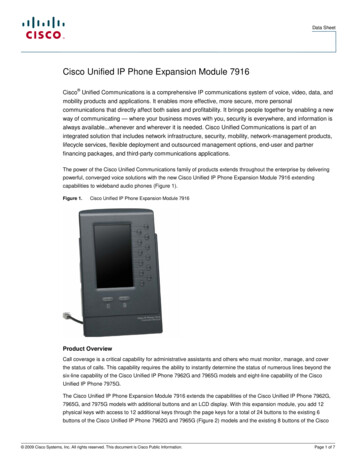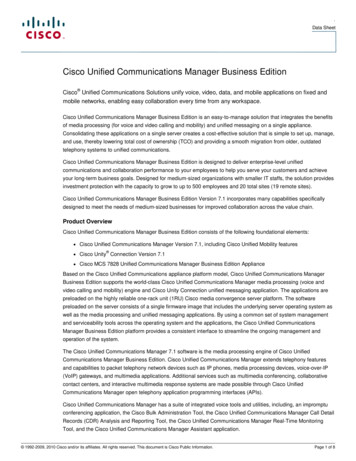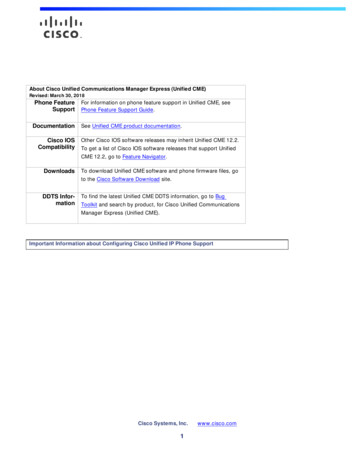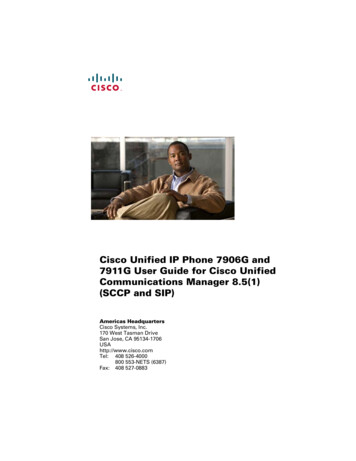
Transcription
Phone GuideCisco Unified IP Phone 7906G and7911G User Guide for Cisco UnifiedCommunications Manager 8.5(1)(SCCP and SIP)Americas HeadquartersCisco Systems, Inc.170 West Tasman DriveSan Jose, CA 95134-1706USAhttp://www.cisco.comTel: 408 526-4000800 553-NETS (6387)Fax: 408 527-0883
ContentsGetting Started 1Using this Guide 1Finding Additional Information 1Accessing Cisco Unified IP Phone 7900 Series eLearning Tutorials 2Safety and Performance Information 2Cisco Product Security Overview 3Accessibility Features 3Connecting Your Phone 5An Overview of Your Phone 9Understanding Buttons and Hardware 9Understanding Lines vs. Calls 11Understanding Line and Call Icons 11Accessing Applications Menus 12Accessing the Help System on Your Phone 12Understanding Feature Availability 12Understanding SIP vs. SCCP 13Basic Call Handling 15Placing a Call—Basic Options 15Placing a Call—Additional Options 16Answering a Call 18Ending a Call 19Using Hold and Resume 19Switching Between Multiple Calls 20Switching an In-Progress Call to Another Phone 20Viewing Multiple Calls 21Transferring Calls 21Sending a Call to a Voice Message System 22Cisco Unified IP Phone Guide for Cisco Unified Communications Manager 8.5(1) (SCCP and SIP)iii
Forwarding Calls to Another Number 23Using Do Not Disturb 24Making Conference Calls 25Using Conference Features 25Using Conference 26Using Join 26Using cBarge 27Using Meet-Me 27Viewing or Removing Conference Participants 28Advanced Call Handling 29Speed Dialing 29Picking Up a Redirected Call on Your Phone 31Storing and Retrieving Parked Calls 32Logging Out of Hunt Groups 33Using a Shared Line 33Understanding Shared Lines 33Using Barge to Add Yourself to a Shared-Line Call 34Understanding Barge Features 34Using Barge Features 34Preventing Others from Viewing or Barging a Shared-Line Call 35Making and Receiving Secure Calls 35Tracing Suspicious Calls 37Prioritizing Critical Calls 38Using Cisco Extension Mobility 39Managing Business Calls Using a Single Phone Number 40Using a Handset, Headset, and Speaker 45Using the Group Listen Feature 45Using the Monitor Feature 46Using a Headset 47Using AutoAnswer 47ivOL-22336-01
Changing Phone Settings 49Customizing Rings and Message Indicators 49Customizing the Phone Screen 50Using Call Logs and Directories 51Using Call Logs 51Directory Dialing 53Using Corporate Directory on Your Phone 54Using Personal Directory on Your Phone 55Accessing Voice Messages 57Using the Cisco Unified CM User Options Web Pages 59Accessing Your User Options Web Pages 59Configuring Features and Services on the Web 60Using Personal Directory on the Web 60Using Your Personal Address Book on the Web 60Configuring Fast Dials on the Web 61Using the Address Book Synchronization Tool 62Setting Up Speed Dials on the Web 63Setting Up Phone Services on the Web 64Controlling User Settings on the Web 65Controlling Line Settings on the Web 65Setting Up Phones and Access Lists for Mobile Connect 67Using Cisco WebDialer 69Understanding Additional Configuration Options 71Troubleshooting Your Phone 73General Troubleshooting 73Viewing Phone Administration Data 74Using the Quality Reporting Tool 74Cisco One-Year Limited Hardware Warranty Terms 75Index 77Cisco Unified IP Phone Guide for Cisco Unified Communications Manager 8.5(1) (SCCP and SIP)v
viOL-22336-01
Getting StartedUsing this GuideThis guide provides you with an overview of the features available on your phone. You can read itcompletely for a solid understanding of your phone’s capabilities, or refer to the table below forpointers to commonly-used sections.If you want to.Then.Review safety informationSee Safety and Performance Information, page 2.Connect your phoneSee Connecting Your Phone, page 5.Use your phone after it is installedStart with An Overview of Your Phone, page 9.Learn about the phone buttonsSee Understanding Buttons and Hardware, page 9.Make callsSee Placing a Call—Basic Options, page 15.Put calls on holdSee Using Hold and Resume, page 19.Transfer callsSee Transferring Calls, page 21.Make conference callsSee Making Conference Calls, page 25.Set up speed dialingSee Speed Dialing, page 29.Share a phone numberSee Using a Shared Line, page 33.Use the speaker on the phoneSee Using a Handset, Headset, and Speaker, page 45.Change the ring volume or toneSee Changing Phone Settings, page 49.View your missed callsSee Using Call Logs and Directories, page 51.Listen to your voice messagesSee Accessing Voice Messages, page 57.Finding Additional Information You can access the most current Cisco documentation on the World Wide Web at this ps379/tsd products support series home.html You can access the Cisco website at this URL:http://www.cisco.com/Cisco Unified IP Phone Guide for Cisco Unified Communications Manager 8.5(1) (SCCP and SIP)1
You can access the most current licensing information at this URL:http://www.cisco.com/en/US/docs/voice ip comm/cuipph/all models/openssl license/7900 ssllic.html Cisco international websites:Allows access to international Cisco websites from www.cisco.com by clicking on the Worldwide[change] link at the top of the web page.Accessing Cisco Unified IP Phone 7900 Series eLearningTutorials(SCCP phones only.)The Cisco Unified IP Phone 7900 Series eLearning tutorials use audio and animation to demonstratebasic calling features. You can access eLearning tutorials online (for several phone models) from yourpersonal computer. Look for the eLearning tutorial (English only) for your phone model in thedocumentation list at the following ones/ps379/products user guide list.htmlNoteAlthough eLearning tutorials for the Cisco Unified IP Phone 7906G and 7911G do not exist,refer to the Cisco Unified IP Phone 7900 Series eLearning tutorials for an overview of thecommon IP phone features and functionality.Safety and Performance InformationRefer to these sections for information about the impact of power outages and other devices on yourCisco Unified IP Phone.Power OutageYour accessibility to emergency service through the phone is dependent on the phone being powered.If there is an interruption in the power supply, Service and Emergency Calling Service dialing will notfunction until power is restored. In the case of a power failure or disruption, you may need to reset orreconfigure equipment before using the Service or Emergency Calling Service dialing.Using External DevicesWhen you use external devices with the Cisco Unified IP Phone, Cisco recommends the use ofgood-quality external devices, such as headsets, that are shielded against unwanted radio frequency(RF) and audio frequency (AF) signals.2OL-22336-01
Getting StartedDepending on the quality of these devices and their proximity to other devices such as mobile phonesor two-way radios, some audio noise may still occur. In these cases, Cisco recommends that you takeone or more of these actions: Move the external device and the cables away from the source of the RF or AF signals. Use shielded cables for the external device, or use cables with a better shield and connector. Shorten the length of the external device cable. Apply ferrites or other such devices on the cables for the external device.Cisco cannot guarantee the performance of the system because Cisco has no control over the qualityof external devices, cables, and connectors. The system will perform adequately when suitable devicesare attached using good quality cables and connectors.CautionIn European Union countries, use only headsets that are fully compliant with the EMCDirective [89/336/EC].Cisco Product Security OverviewThis product contains cryptographic features and is subject to United States and local country lawsgoverning import, export, transfer and use. Delivery of Cisco cryptographic products does not implythird-party authority to import, export, distribute or use encryption. Importers, exporters, distributorsand users are responsible for compliance with U.S. and local country laws. By using this product youagree to comply with applicable laws and regulations. If you are unable to comply with U.S. and locallaws, return this product immediately.Further information regarding U.S. export regulations may be found at:http://www.access.gpo.gov/bis/ear/ear data.htmlAccessibility FeaturesThe Cisco Unified IP Phone 7900 Series provides accessibility features for the vision impaired, theblind, and the hearing and mobility impaired.For detailed information about the features on these phones, see Accessibility Features for the CiscoUnified IP Phone 7900 Series.You can also find more information about accessibility at this Cisco ity/accessibility/index.htmlCisco Unified IP Phone Guide for Cisco Unified Communications Manager 8.5(1) (SCCP and SIP)3
4OL-22336-01
Connecting Your PhoneConnecting Your PhoneYour system administrator will likely connect your new Cisco Unified IP Phone to the corporate IPtelephony network. If that is not the case, refer to the graphics below to connect your phone.The following graphic and table show how to connect the Cisco Unified IP Phone 7906G.324Network port (10/100 SW)12Handset port3DC adapter port (DC48V)79976514AC-to-DC powersupply5AC power cordCisco Unified IP Phone Guide for Cisco Unified Communications Manager 8.5(1) (SCCP and SIP)5
The following graphic and table show how to connect the Cisco Unified IP Phone 7911G:416259163831Network port (10/100 SW)4DC adapter port (DC48V)2Access port (10/100 PC)5AC-to-DC power supply3Handset port6AC power cord6OL-22336-01
Connecting Your PhoneAdjusting the Handset RestWhen you connect your phone, you might want to adjust the handset rest to ensure that thereceiver will not slip out of the cradle. See the table below for instructions.237735411Set the handset aside and pull the square plastic tab from the handset rest.2Rotate the tab 180 degrees.3Slide the tab back into the handset rest. An extension protrudes from the top of the rotated tab.Return the handset to the handset rest.Registering with TAPSAfter your phone is connected to the network, your system administrator might ask you toauto-register your phone using the Tool for Auto-Registered Phones Support (TAPS). TAPS might beused either for a new phone or to replace an existing phone.To register with TAPS, pick up the handset, enter the TAPS extension provided by your systemadministrator, and follow the voice prompts. You might need to enter your entire extension, includingthe area code. After your phone displays a confirmation message, hang up. The phone will restart.Headset SupportAlthough Cisco Systems performs limited internal testing of third-party headsets for use with theCisco Unified IP Phones, Cisco does not certify or support products from headset (or handset) vendors.Cisco recommends the use of good quality external devices, for example, headsets that are screenedagainst unwanted radio frequency (RF) and audio frequency (AF) signals. Depending on the quality ofthese devices and their proximity to other devices such as mobile phones and two-way radios, someCisco Unified IP Phone Guide for Cisco Unified Communications Manager 8.5(1) (SCCP and SIP)7
audio noise or echo may still occur. An audible hum or buzz may be heard by either the remote partyor by both the remote party and the Cisco Unified IP Phone user. Humming or buzzing sounds can becaused by a range of outside sources: for example, electric lights, electric motors, or large PC monitors.See Using External Devices, page 2 for more information.NoteIn some cases, hum may be reduced or eliminated by using a local power cube or powerinjector.These environmental and hardware inconsistencies in the locations where Cisco Unified IP Phones aredeployed means that there is not a single headset solution that is optimal for all environments.Cisco recommends that customers test headsets in their intended environment to determineperformance before making a purchasing decision and deploying en mass.Audio Quality Subjective to the UserBeyond the physical, mechanical and technical performance, the audio portion of a headset mustsound good to the user and to the party on the far end. Sound quality is subjective and Cisco cannotguarantee the performance of any headsets. However, a variety of headsets from leading headsetmanufacturers have been reported to perform well with Cisco Unified IP Phones. See manufacturer’ssites for details.8OL-22336-01
An Overview of Your PhoneAn Overview of Your PhoneCisco Unified IP Phone 7906G and 7911G are full-feature telephones that provide voicecommunication over the same data network that your computer uses, allowing you to place andreceive calls, put calls on hold, transfer calls, make conference calls, and so on.In addition to basic call-handling features, your Cisco Unified IP Phone 7906G and 7911G can providespecialized or advanced telephony features that extend your call-handling capabilities. Depending onconfiguration, your phone supports: Access to network data, XML applications, and web-based services. Online customizing of phone features and services from your Cisco Unified CM User Options webpages.Understanding Buttons and HardwareYou can use this graphic below to identify the buttons and hardware on your phone.1298345679103110Cisco Unified IP Phone Guide for Cisco Unified Communications Manager 8.5(1) (SCCP and SIP)9
For more information,see.ItemDescription1Phone screenDisplays phone menus and call activityAccessing Applicationsincluding caller ID, call duration, and call state. Menus, page 12 andUnderstanding FeatureAvailability, page 12.2Cisco Unified IPPhone seriesIndicates your Cisco Unified IP Phone modelseries.—3Softkey buttonsEach activates a softkey option displayed onyour phone screen.—4Navigation buttonAllows you to scroll through menu items andhighlight items. When the phone is on-hook,displays your Speed Dials.Accessing ApplicationsMenus, page 12 andSpeed Dialing, page 29.5Applications MenubuttonDisplays the Applications menu that providesaccess to a voice message system, phone logsand directories, settings, services, and help.Accessing ApplicationsMenus, page 12.6Hold buttonPlaces the active call on hold, resumes a call on Using Hold andhold, and switches between an active call and a Resume, page 19.call on hold.7KeypadAllows you to dial phone numbers, enterletters, and choose menu items.Basic Call Handling,page 15.8Volume buttonControls the handset, headset, speaker, andringer volume.Using a Handset,Headset, and Speaker,page 45.9Handset with lightstripThe light strip on the handset indicates anincoming call or new voice message.Accessing VoiceMessages, page 57.10 Footstand10Allows the phone to stand at a convenient angle —on a desk or table.OL-22336-01
An Overview of Your PhoneUnderstanding Lines vs. CallsTo avoid confusion about lines and calls, refer to these descriptions: Lines—Each line corresponds to a phone number (or extension) that others can use to call you.Your phone can support one line. Calls—Each line can support multiple calls. By default, your phone supports up to six connectedcalls, but your system administrator can adjust this number according to your needs. Only one callcan be active at any time; other calls are automatically placed on hold.Understanding Line and Call IconsYour phone displays icons to help you determine the call and line state (on-hook, on hold, ringing,connected, and so on).IconCall or line stateDescriptionOn-hook lineNo call activity on this line.Off-hook lineYou are dialing a number or an outgoing call is ringing.Connected callYou are connected to the other party.Ringing callA call is ringing on your line.Call on holdYou have put this call on hold. See Using Hold and Resume,page 19.Remote call onholdAnother phone that shares your line has put a call on hold. SeeUsing Hold and Resume, page 19.Remote-in-useAnother phone that shares your line has a connected call. SeeUnderstanding Shared Lines, page 33.Reverting callA holding call is reverting to your phone. See Using Hold andResume, page 19.Authenticated callSee Making and Receiving Secure Calls, page 35.Encrypted callSee Making and Receiving Secure Calls, page 35.Cisco Unified IP Phone Guide for Cisco Unified Communications Manager 8.5(1) (SCCP and SIP)11
Accessing Applications MenusUse the Applications menus to access phone features.If you want to.Then.Access the ApplicationsmenusPressto display a list of Applications: Messages, Directory,Settings, Services, and Help.Scroll through a list ormenuPressSelect a menu itemPressto highlight a menu item, then press Select. You can also press the number on the keypad that correspondsto the number for the menu item.Go back one level in a menu Press Exit. (Note that if you press Exit from the top-level of amenu, the menu will close.)Close a menu (and return to Press Exit one or more times until the menu closes, or pressthe Applications menu)Exit the Applications menu Press.or Exit.TipAfter you press, the LED turns green and stays lit while you are using the Applications menus. Ifyou depart from an application without pressingor Exit (for example, to answer a new call), thephone screen display may change but thebutton stays green. If you pressagain, theapplication that you were using resumes at the point when it was interrupted.Accessing the Help System on Your PhoneThe Cisco Unified IP Phone 7906G and 7911G provide a comprehensive online help system. To viewand choose Help.the phone help, pressUnderstanding Feature AvailabilityDepending on your phone system configuration, features included in this Phone Guide might not beavailable to you or might work differently on your phone. Contact your support desk or systemadministrator for information about feature operation or availability.12OL-22336-01
An Overview of Your PhoneUnderstanding SIP vs. SCCPYour phone can be configured to work with one of two signaling protocols: SIP (Session InitiationProtocol) or SCCP (Skinny Call Control Protocol). Your system administrator determines thisconfiguration.Phone features can vary depending on the protocol. This Phone Guide indicates which features areprotocol-specific. To learn which protocol your phone is using, you can ask your system administrator Model Information Call Control Protocol on your phone.or you can chooseCisco Unified IP Phone Guide for Cisco Unified Communications Manager 8.5(1) (SCCP and SIP)13
14OL-22336-01
Basic Call HandlingBasic Call HandlingYou can perform basic call-handling tasks using a range of features and services. Feature availabilitycan vary; see your system administrator for more information.Placing a Call—Basic OptionsHere are some easy ways to place a call on your Cisco Unified IP Phone.For more information,see.If you want to.Then.Place a callPick up the handset and dial the number.An Overview of YourPhone, page 9.Dial on-hook (with dial Press New Call and dial the number.tone)—Redial a numberPress Redial.—Place a call whenanother call is active1. Press.2. Press New Call.Using Hold andResume, page 19.3. Enter a number.Dial from a call log1. Pressand select Directories MissedCalls, Received Calls, or Placed Calls.Using Call Logs,page 51.2. Scroll to the number and press Dial.Tips You can dial on-hook without a dial tone (pre-dial). To pre-dial, enter a number, then go off-hookby lifting the handset and press Dial. When you pre-dial, your phone tries to anticipate the number you are dialing by displayingmatching numbers (if available) from your Placed Calls log. This is called Auto Dial. To call anumber displayed with Auto Dial, scroll to it, press Dial, and go off-hook. If you make a mistake while dialing, press to erase digits. If parties on a call hear a beep tone, the call might be monitored or recorded. Ask your systemadministrator for more information. Your phone might be set up for international call logging, which is indicated by a “ ” symbol onthe call logs, redial, or call directory entries. See your system administrator for more information.Cisco Unified IP Phone Guide for Cisco Unified Communications Manager 8.5(1) (SCCP and SIP)15
Placing a Call—Additional OptionsYou can place calls using special features and services that might be available on your phone. See yoursystem administrator for more information about these additional options.If you want to.Then.For more information,see.Dial from a corporatedirectory on your personalcomputer usingCisco WebDialer1. Open a web browser and go to aWebDialer-enabled corporatedirectory.UsingCisco WebDialer,page 69.Use CallBack to receivenotification when a busy orringing extension is available1. Press CallBack while listening to thebusy tone or ring sound.2. Click the number that you want todial.Your systemadministrator.2. Hang up. Your phone alerts you whenthe line is free.3. Place the call again.NoteThe CallBack feature is disabled on aCall Chaperone user’s Cisco UnifiedIP Phone when the calls are beingchaperoned.Make a priority (precedence)call (SCCP phones only)Enter the Multilevel Precedence andPreemption (MLPP) access number, thenenter a phone number.Dial from a Personal AddressBook (PAB) entry1. Pressand select Directories Personal Directory to log in.2. Choose Personal Address Book andsearch for a listing.Prioritizing CriticalCalls, page 38. Using the CiscoUnified CM UserOptions WebPages, page 59. Using PersonalDirectory on YourPhone, page 55.Place a call using a billing ortracking code1. Dial a number.(SCCP phones only)2. After the tone, enter a client mattercode (CMC) or a forced authorizationcode (FAC).Place a call using your CiscoExtension Mobility profileLog in to the Cisco Extension Mobilityservice on a phone.16Your systemadministrator.Using Cisco ExtensionMobility, page 39.OL-22336-01
Basic Call HandlingFor more information,see.If you want to.Then.Make a call from a mobilephone using Mobile VoiceAccess1. Obtain your Mobile Voice Accessnumber and End user PIN from yoursystem administrator.2. Dial your assigned Mobile Voiceaccess number.Managing BusinessCalls Using a SinglePhone Number,page 40.3. Enter your mobile phone number (ifrequested) and PIN.4. Press 1 to make a call to an enterpriseIP phone.5. Dial a desktop phone number otherthan your desktop phone number.Place a call using Fast DialNoteBefore using this option, your systemadministrator must configure thisfeature and assign a service URL tothe line button. Contact your systemadministrator for more information.Configuring Fast Dialson the Web, page 61and Using YourPersonal Address Bookon the Web, page 601. Press the Fast Dial line button.2. Scroll to or press the index number tofind and select an entry.The system dials the specified number.Place a call using your PABNoteBefore using this option, your systemadministrator must configure thisfeature and assign a service URL tothe line button. Contact your systemadministrator for more information.Configuring Fast Dialson the Web, page 61and Using YourPersonal Address Bookon the Web, page 601. Press the PAB line button.2. Access the contact and select thenumber.The system dials the specified number.Cisco Unified IP Phone Guide for Cisco Unified Communications Manager 8.5(1) (SCCP and SIP)17
Answering a CallYou can answer a call by simply lifting the handset, or you can use other options if they are availableon your phone.If you want to.Then.For more information, see.Switch from a connectedcall to answer a new callPress Answer.Using Hold and Resume, page 19.Answer a call using callwaitingPress Answer.Using Hold and Resume, page 19.Send a call to a voicemessage systemPress iDivert.Sending a Call to a Voice MessageSystem, page 22.Automatically connectincoming callsUse AutoAnswer.Using AutoAnswer, page 47.Retrieve a parked call onanother phoneUse Call Park or Directed Call Park.Storing and Retrieving ParkedCalls, page 32.Use your phone to answer Use Call Pickup.a call ringing elsewherePicking Up a Redirected Call onYour Phone, page 31.Answer a priority call(SCCP phones only)Hang up the current call and pressAnswer.Prioritizing Critical Calls,page 38.Answer a call on yourmobile phone or otherremote destinationSet up Mobile Connect and answeryour phone.Managing Business Calls Using aSingle Phone Number, page 40.When you enable Mobile Connect: Your desktop and remotedestinations receive callssimultaneously. When you answer the call onyour desktop phone, the remotedestinations stop ringing, aredisconnected, and display amissed call message. When you answer the call onone remote destination, theother remote destinations stopringing, are disconnected, and amissed call message is shown onthe other remote destinations.18OL-22336-01
Basic Call HandlingTips If parties on a call hear a beep tone, the call might be monitored or recorded. Ask your systemadministrator for more information. If you work in a contact center or similar environment, you can create, update, and delete yourown prerecorded greeting that plays automatically if Agent Greeting is configured for your phone.For more information, see your system administrator. A Call Chaperone user cannot answer an incoming call when the calls are being chaperoned.Ending a CallTo end a call, simply hang up. Here are some more details.If you want to.Then.Hang up while using the handsetReturn the handset to its cradle. Or press EndCall.Hang up while monitoring a call (using Press EndCall.the speaker)Hang up one call, but preserve another Press EndCall. If necessary, remove the call from hold first.call on the same lineUsing Hold and ResumeYou can hold and resume calls. When you put a call on hold, the Hold iconappears next to thecall timer and in the line area. When using a shared line and another phone user puts the call on hold,appears next to the call timer and in the line area. In both cases, the holdthe Remote Hold iconLED is solid red.If the Hold Reversion feature is enabled for your phone, a call that you put on hold reverts back toringing after a certain period of time. The “reverting” calls remains on hold until you resume it or untilHold Reversion times out.Your phone indicates the presence of a reverting call by: Alerting you at intervals with a single ring (or flash or beep, depending on your phone line setting). Briefly displaying a “Hold Reversion” message in the status bar at the bottom of the phone screen. Displaying the animated Hold Reversion iconnext to the caller ID for the held call.If you want to.Then.Put a call on hold1. Make sure the call you want to put on hold is highlighted.2. PressRemove a call from hold.1. Make sure the appropriate call is highlighted.2. Press.Cisco Unified IP Phone Guide for Cisco Unified Communications Manager 8.5(1) (SCCP and SIP)19
Tips Engaging the Hold feature typically generates music or a beeping tone. When a held call is highlighted, the Hold buttonbecomes lit (red). When a call that is not heldis highlighted, and there are other held calls on the line, the Hold button changes to blinking (red). If you receive an alert for an incoming call and a reverting call at the same time, by default yourphone will shift the focus of the phone screen to display the incoming call. Your systemadministrator can change this focus priority setting. If you use a shared line, Hold Reversion rings only on the phone that put the call on hold, not onthe other phones that share the line. The duration between Hold Reversion alerts is determined by your system administrator. The Hold feature is disabled on a Call Chaperone user’s Cisco Unified IP Phone when the calls arebeing chaperoned.Switching Between Multiple CallsYou can switch between multiple calls on your phone.If you want to.Then.Switch between connectedcalls1. Make sure the call that you want to switch to is highlighted.Switch from a connected callto answer a ringing callPress Answer. Any active call is placed on hold.2. Press. Any active call is placed on hold and the selected callis resumed.Switching an In-Progress Call to Another PhoneYou can switch in-progress calls between the desktop phone and your mobile phone or other remotedestination.If you want to.Then.Switch an in-progresscall on your desktopphone to a mobilephone1. Press the Mobility softkey and select Send call to mobile.202. Answer the in-progress call on your mobile phone.OL-22336-01
Basic Call HandlingIf you want to.Then.Switch an in-progresscall from a mobilephone to your desktopphone1. Hang up the call on your mobile phone to disconnect the mobilephone, but not the call.Switch an in-progresscall from a mobilephone to a desk phonesharing the same line(Session Handoff)1. While on your mobile phone, press the access code for the SessionHandoff feature (for example, *74). See your system administrator fora list of access codes.2. Press Answer softkey on your desk phone within 4 seconds and starttalking on the desk phone.2. Hang up the call on your mobile phone to disconnect the mobilephone, but not the call.3. Press the Answer softkey on your desk phone within 10 seconds andstart talking on the desk phone. The number of seconds to answer thecall on your desk phone is set by your system administrator.The other Cisco Unified devices that share the same line display a Remotein Use message. The number of seconds to resume the call depends on theconfiguration set by the system administrator.Viewing Multiple CallsUnderstanding how multiple calls are displayed on your phone can help you organize yourcall-handling efforts.Your phone displays calls as follows for the highlighted line: Calls with the highest precedence and longest duration display at the top of the list. Calls of a similar type are grouped together. For example, calls that you have interacted with aregrouped near the top, and calls on hold are grouped last.Transferring CallsTransfer
Cisco Unified IP Phone Guide for Cisco Unified Communications Manager 8.5(1) (SCCP and SIP) iii Contents Getting Started 1 Using this Guide 1 Finding Additional Information 1 Accessing Cisco Unified IP Phone 7900 Series eLearning Tutorials 2 Safety and Performance Information 22


